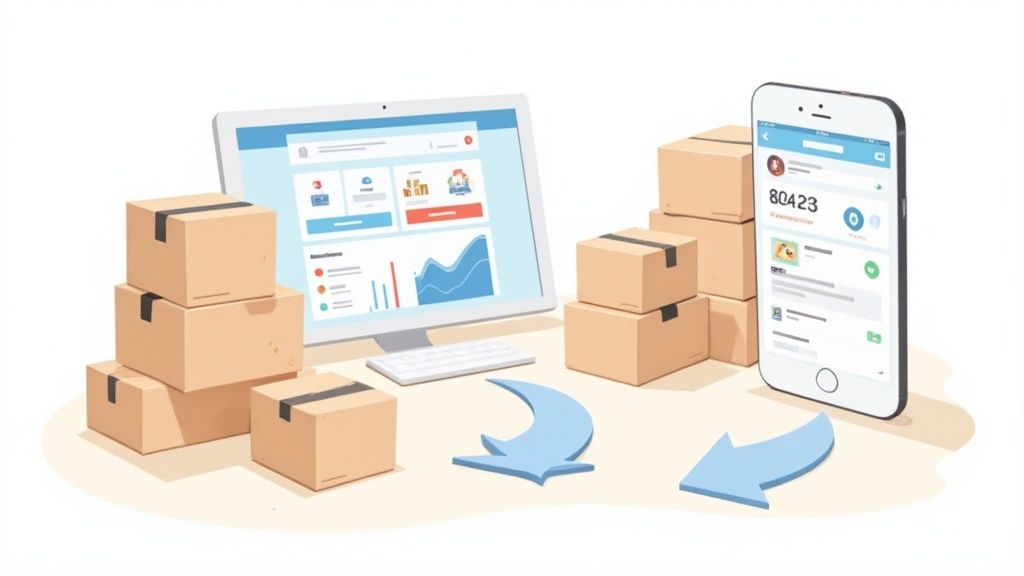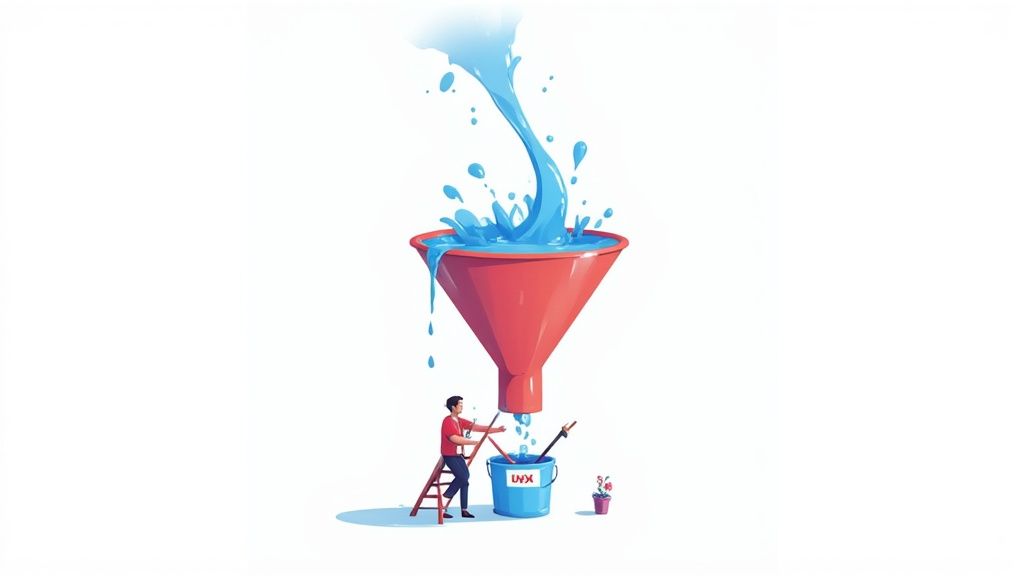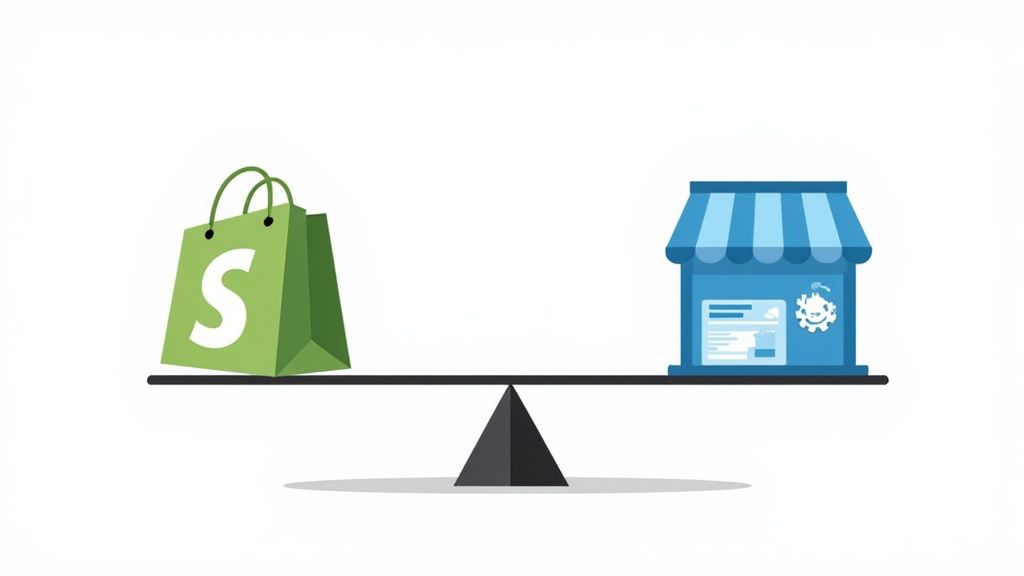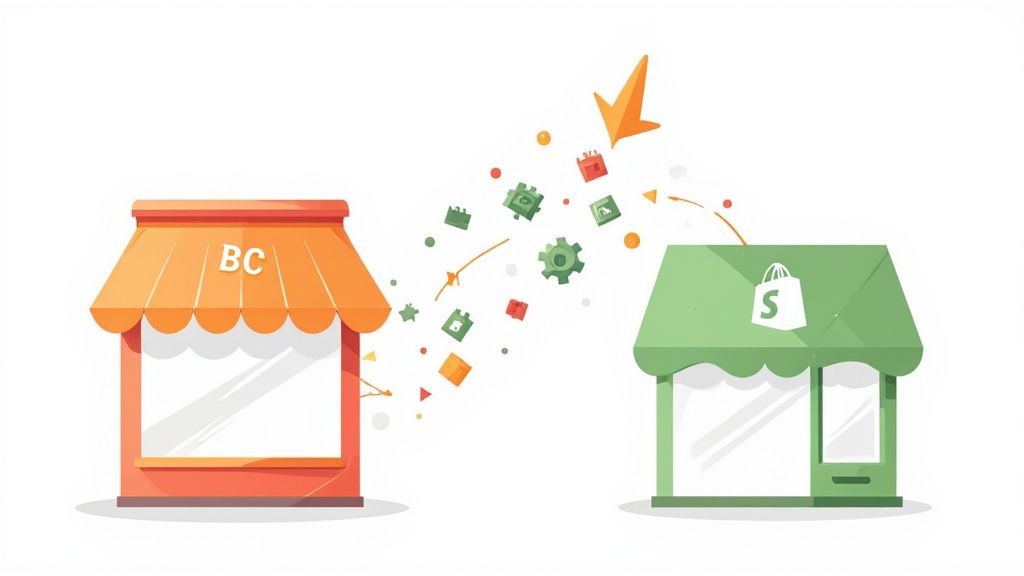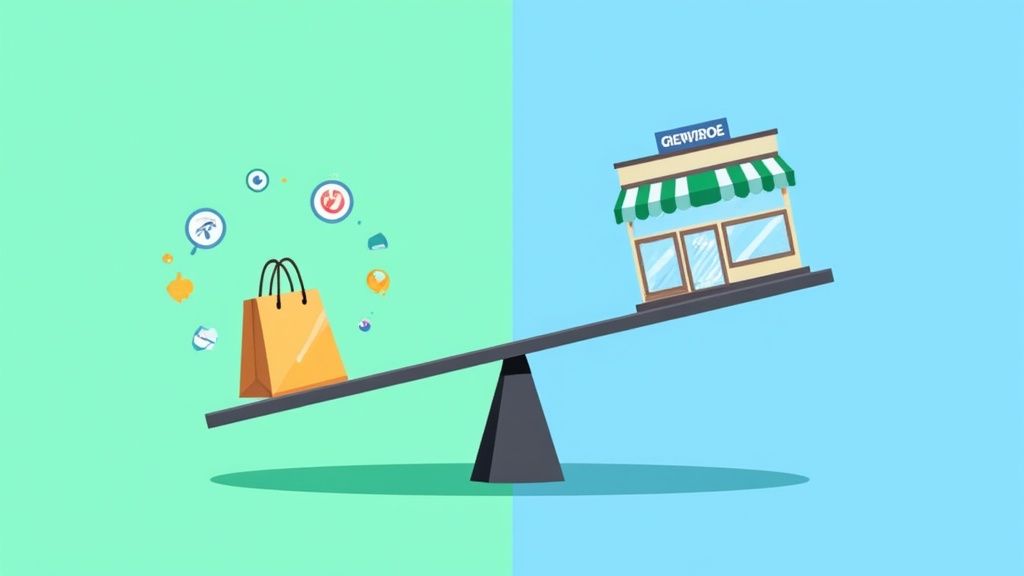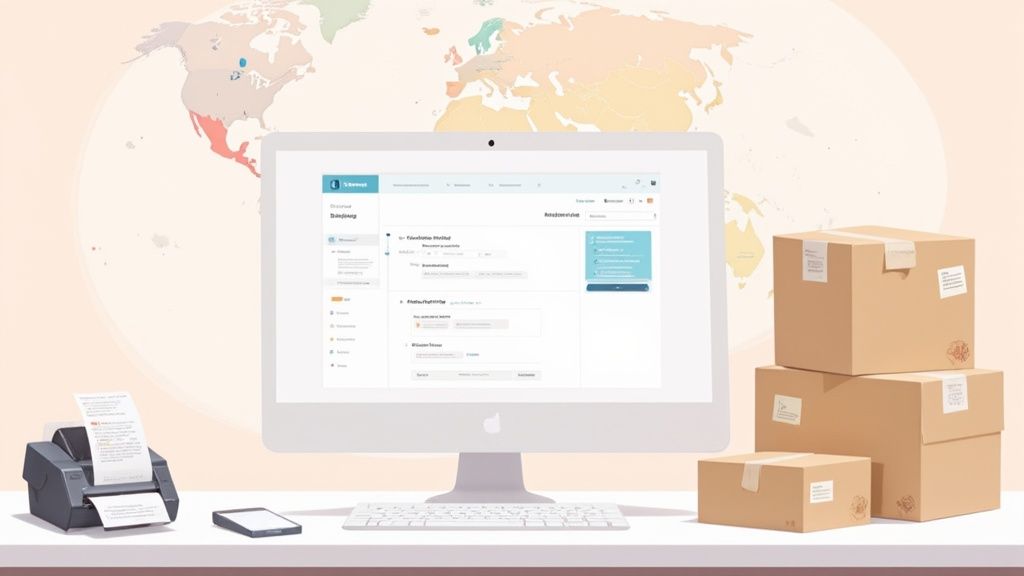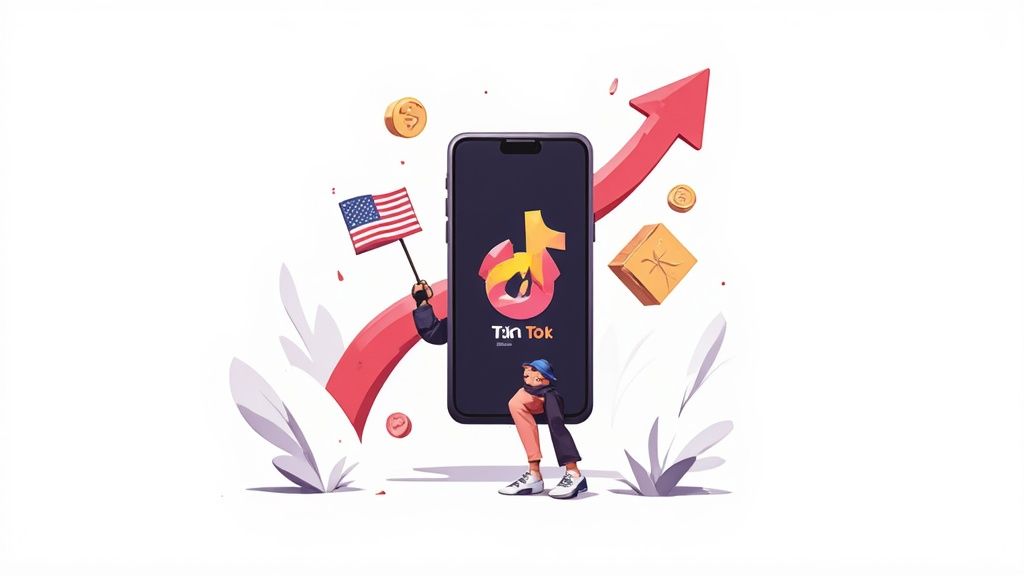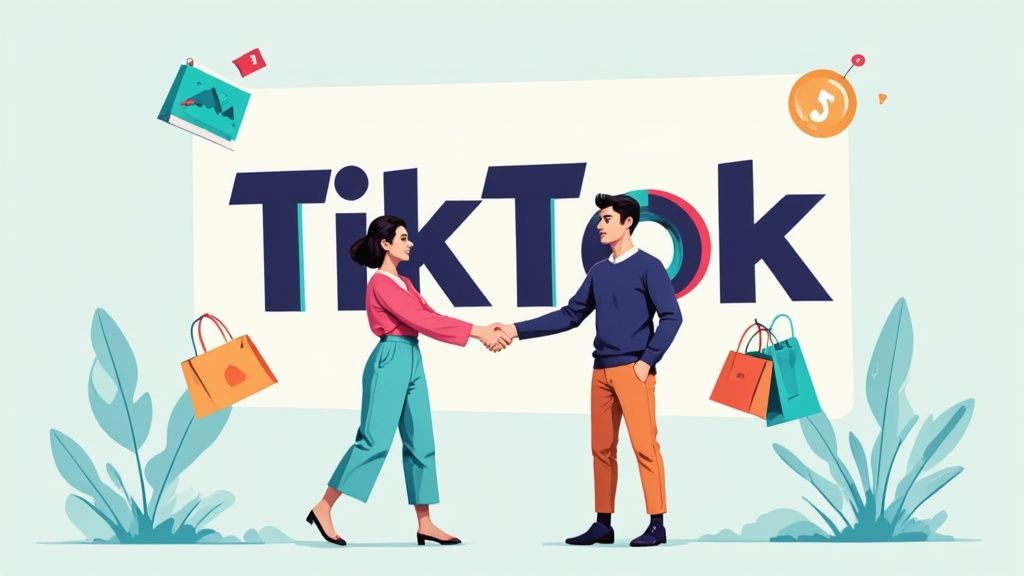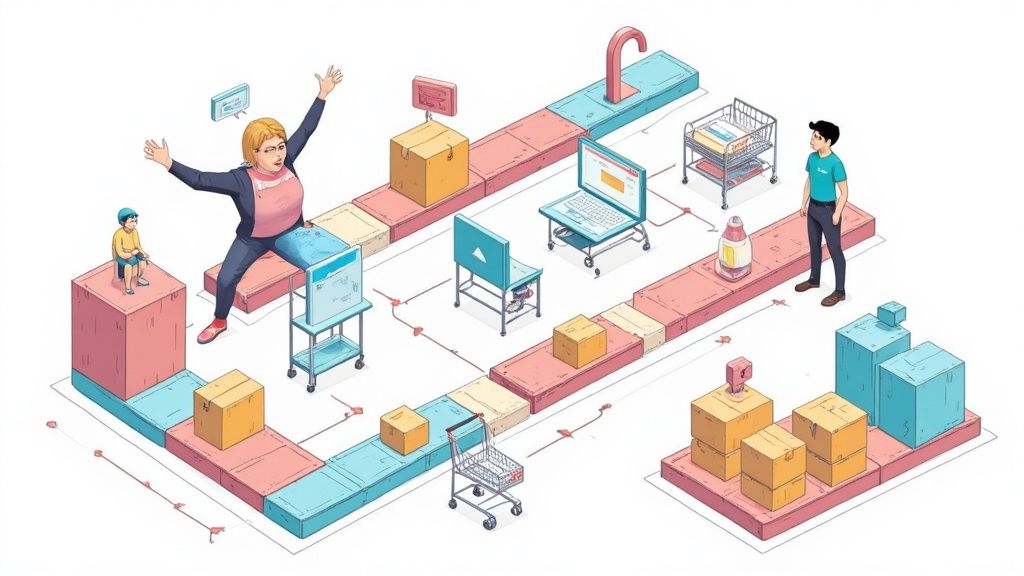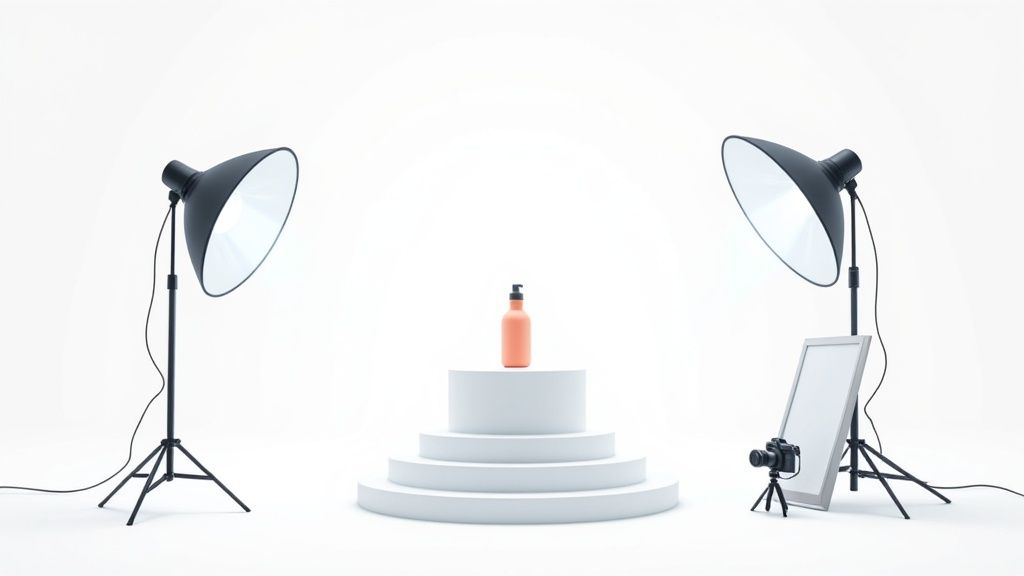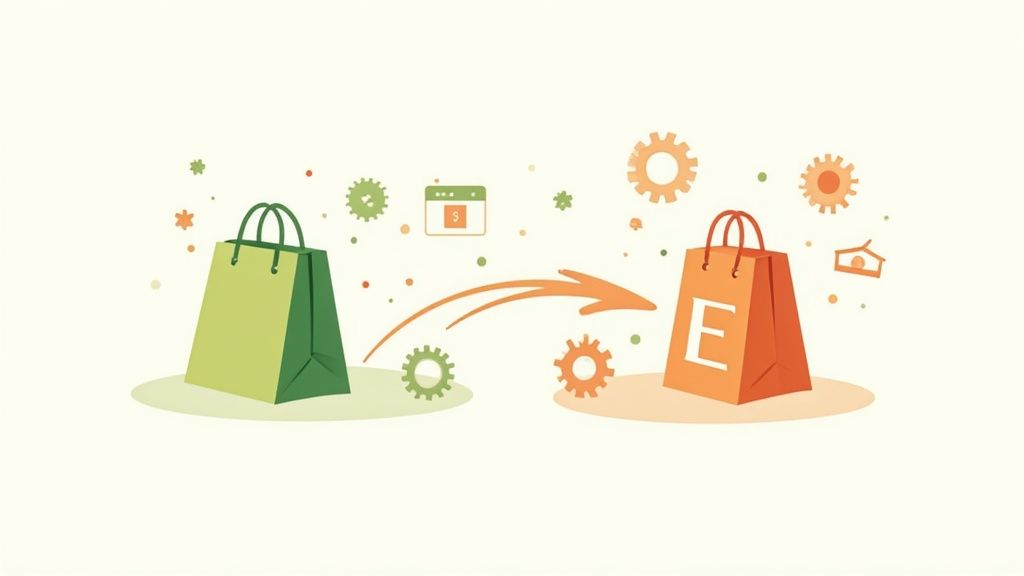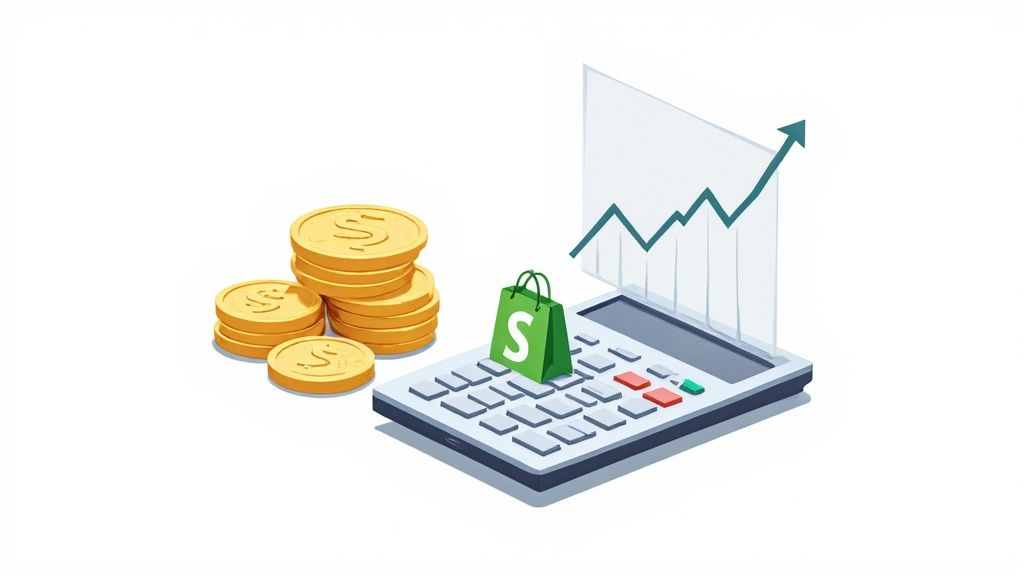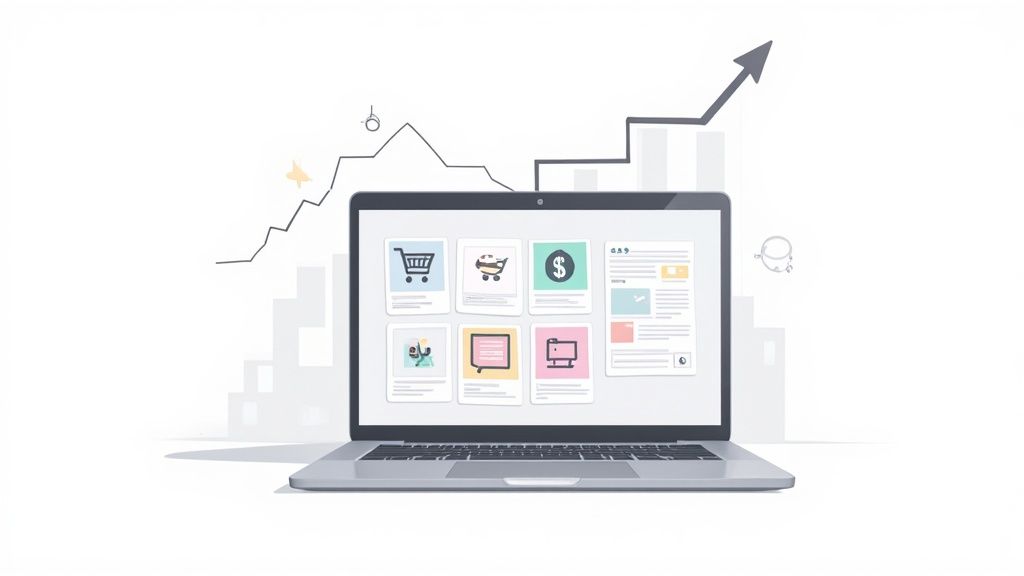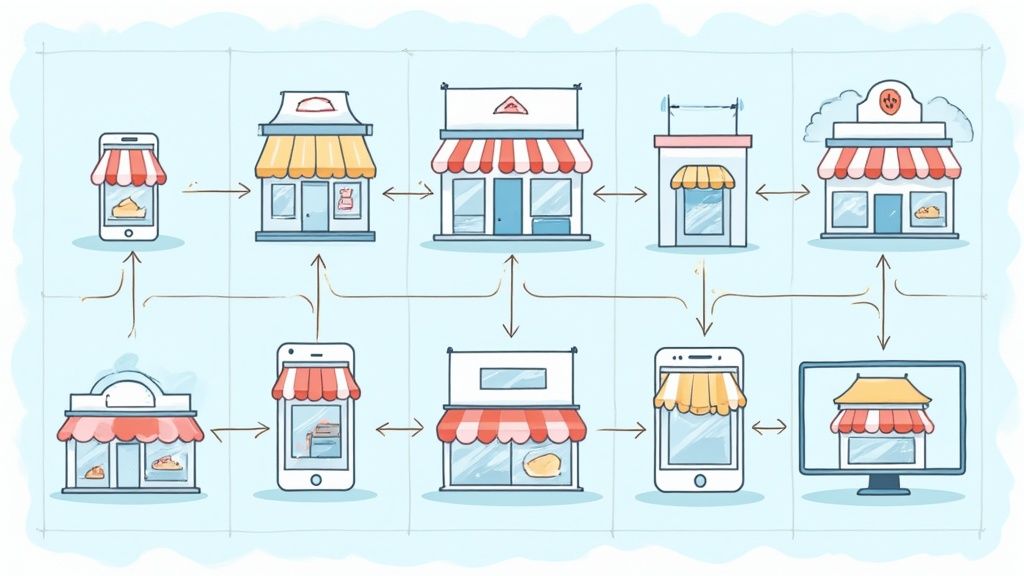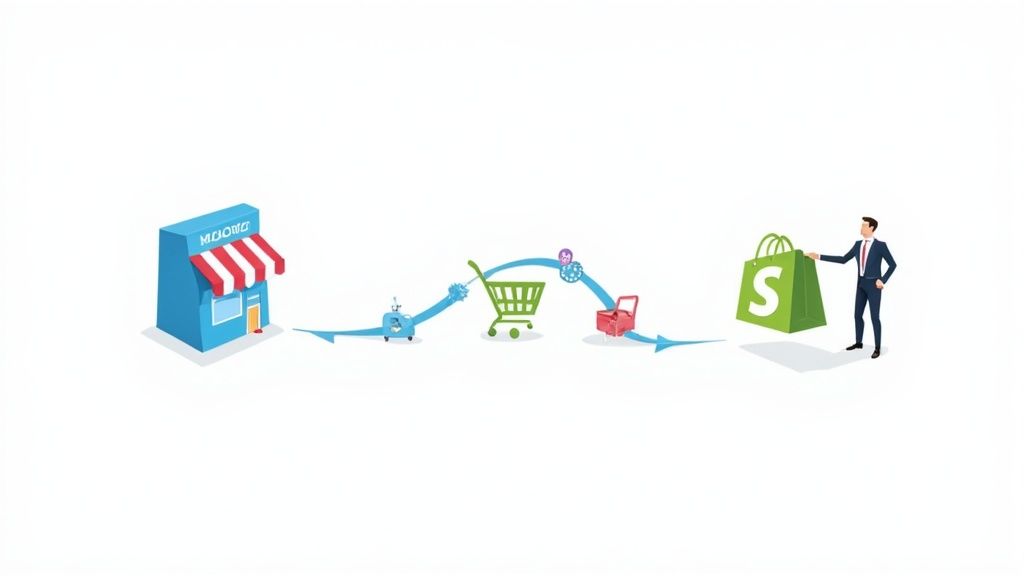
The TikTok Shop Seller Center is where the magic happens. It’s your control panel, your mission control, your single source of truth for running an e-commerce business right inside the TikTok app. Think of it as the brain behind your shop where you'll manage literally everything—from listing products and checking inventory to shipping orders, running promotions, and handling customer questions. It’s a surprisingly powerful dashboard built to turn viral moments into actual money in your pocket.
Your Command Center for TikTok Commerce

Welcome to the engine room of your social commerce operation. The TikTok Shop Seller Center is way more than just a dashboard; it’s the bridge connecting your products to one of the most ridiculously engaged audiences on the internet. This guide isn't about the basics—it's about showing you exactly how the pros use this platform to turn fleeting trends into a reliable revenue stream.
This is your roadmap to mastering the tools that really matter. Inside the Seller Center, you'll touch every part of your business, from the first day of setup to your long-term growth strategy.
What You'll Actually Do in the Seller Center
The real beauty of the platform is how tightly everything is integrated. You don't need a separate website or a bunch of clunky third-party tools to get the core stuff done.
Here’s a quick rundown of your day-to-day:
- Product Management: This is where you’ll upload new products, write those catchy descriptions, tweak your pricing, and manage different sizes or colors.
- Order Fulfillment: From the second a purchase is made, you'll track it here. You’ll print shipping labels, keep an eye on delivery status, and handle any returns that come through.
- Performance Analytics: Your data hub. See what's selling, where your traffic is coming from, and how customers are behaving. This is where you'll find the insights to make smarter business decisions.
- Marketing & Promotions: Set up discounts, flash sales, affiliate programs, and—most importantly—manage your collaborations with creators.
And the ecosystem you're tapping into is massive. As of 2025, there are around 15 million merchants selling on TikTok Shop worldwide. Over 500,000 of those are right here in the United States, all managing their stores from within the Seller Center. If you want to dive deeper into the numbers, AMZScout has some great data on TikTok Shop's growth.
The biggest unlock with the Seller Center is how it closes the gap between content and commerce. I’ve seen it happen: a video goes viral at 2 PM, and by 2:05 PM, the orders are flooding in. You can see and manage it all in real-time, right in one interface.
This guide will give you the practical steps to get started and the expert tips to fine-tune every part of your shop. My goal is to make sure you're ready to capitalize on this huge opportunity.
Getting Your Shop Live and Ready for Business

Alright, this is where you make the leap from TikTok viewer to TikTok vendor. The initial setup in the Seller Center is your first major hurdle, and trust me, getting this part right from the get-go will save you a world of headaches later on. Think of this as laying the foundation for your entire TikTok business—it's more than just filling out a few forms.
First up, you'll need to decide whether to register as an Individual or a Corporate seller. This choice determines the kind of paperwork you'll need and how you can operate. Don't just click the first option you see. Think about where you want your business to go. Are you a solo creator just starting to monetize a passion project, or are you building a full-fledged, registered brand?
Gathering Your Essential Documents
I can't stress this enough: get all your paperwork in order before you even start the application. Mismatched information is the number one reason I see shops get rejected, so every detail matters.
For Individual Sellers, you’ll generally need:
- A government-issued ID, like your passport or driver's license.
- Your personal contact details and, depending on your region, a tax identification number.
For Corporate Sellers, the list is a bit longer:
- Official business registration documents (your LLC or Corporation papers, for instance).
- Your company's Employer Identification Number (EIN) or equivalent tax ID.
- Contact information for the company's legal representative.
A classic mistake is a tiny name variation between a business license and the bank account. Even something as small as a missing "Inc." or "LLC" can flag your application for a manual review, adding days—sometimes weeks—to your approval time. Double-check that every single detail matches perfectly across all documents.
Once you hit submit, the verification process kicks off. TikTok tries to be quick, but the fastest way to get approved is to give them perfectly clean information on the first try. If everything is clear and consistent, you can expect approval in about 1-3 business days.
Configuring Your Shop Profile and Payouts
Once you get that sweet approval notification, it's time to build out your shop's profile and start earning trust. This means picking a catchy shop name, uploading a crisp logo, and writing a short, punchy bio that tells customers exactly who you are and what you're all about.
Next, and this is crucial, you have to link your bank account for payouts. Head over to the "Finance" section in the TikTok Shop Seller Center and carefully enter your information. This is how you get paid, so there’s zero room for error. The name on the bank account must be an exact match for the name on your seller account, whether that's your personal name or your official business name. Any mismatch will put a freeze on your payouts until it's sorted out.
As you start planning your launch, you'll want to make sure you're stocking products people actually want to buy. You can discover proven strategies to find trending products to fill your new store with items that already have some buzz. And if you're already selling on another platform, connecting your existing catalog can be a huge time-saver. We cover exactly how to integrate TikTok Shop with Shopify in our detailed guide.
https://www.ecorn.agency/blog/tiktok-shop-shopify
Creating Product Listings That Actually Convert
A great product can get completely lost in the noise if its listing doesn't hit the mark. Think of your product page in the TikTok Shop Seller Center as more than just a data entry form. It's your digital storefront, your 24/7 sales pitch, and the first real touchpoint for a potential customer—all rolled into one.
Getting this right means creating a listing that not only stops the scroll but also drives someone to actually click "buy." It's a blend of art and science, and it has to be tailored specifically for the fast-paced, video-first world of TikTok. The whole point is to make the journey from a viral video to a completed purchase as seamless as possible.
Writing Titles and Descriptions for Discovery
Your product title is the very first thing anyone sees. It has to be crystal clear, descriptive, and packed with the exact terms your audience is searching for. Let's be honest, a title like "Cool Skincare Serum" is lazy and forgettable. Something like "Hydrating Glow Serum with Hyaluronic Acid," on the other hand, is specific, informative, and immediately targets users looking for those ingredients.
The description is where you sell the story behind the product. Ditch the long paragraphs. Use short, punchy sentences and bullet points to hammer home the key benefits. Never just list features—explain how they solve a problem or make the customer's life better.
- Feature: Contains Vitamin C
- Benefit: Brightens dull skin and fades dark spots for a radiant, even-toned complexion.
See the difference? This approach connects the product directly to a desired outcome, making it far more persuasive. You're writing for a mobile-first audience with a notoriously short attention span, so make every word count.
Nailing Your Visuals, TikTok Style
On TikTok, visuals are everything. Your standard, sterile product photos shot against a white background are likely to fall flat here. The platform’s culture thrives on authenticity, movement, and content that feels native to the For You Page.
This means you need to prioritize short-form video. A quick 15-second clip showing your product in action is infinitely more powerful than a static image. Imagine a video of someone effortlessly cleaning a tough spill with a new gadget versus just a picture of the gadget. The video demonstrates the value instantly and builds trust.
Your product's visual strategy should mirror the kind of content that already performs well on TikTok. Think user-generated content (UGC) style, behind-the-scenes looks, and quick, satisfying demos. Authenticity is currency on this platform; it builds trust far more effectively than a polished, corporate-style product shoot ever could.
Don't abandon images entirely, but make sure they're optimized for the platform. Use a mix of high-quality lifestyle shots that show the product in a real-world context alongside clean, clear images that highlight specific features or details.
Using Categories and Attributes to Boost Visibility
Properly categorizing your products is a non-negotiable step if you want people to find them. Inside the TikTok Shop Seller Center, you need to get as specific as you possibly can. Don't just list a shirt under "Apparel." Drill down to "Women's Apparel > Tops > T-Shirts." This precision helps TikTok's algorithm serve your product up to the most relevant shoppers.
Equally important are the product attributes—all those little details like size, color, material, and style. Filling these out meticulously accomplishes two critical things:
- It lets users filter their searches to find exactly what they’re looking for.
- It feeds the algorithm more data, helping it match your product to interested buyers with greater accuracy.
Think of each attribute as another signal you’re sending to TikTok about who needs to see your listing. A product with complete, accurate attributes has a much higher chance of appearing in relevant search results and recommendations, which is how you turn casual browsers into loyal customers.
To help you structure your listings for maximum impact, here’s a breakdown of the most critical components and how to get them right.
Key Product Listing Components and Best Practices
Taking the time to build out each of these components thoughtfully isn't just busywork—it's the foundation of a successful TikTok Shop strategy. A well-optimized listing works for you around the clock, improving your visibility and turning views into revenue.
Making Sure Your Order and Fulfillment Workflow Is Rock-Solid
Once you start seeing sales notifications, the game completely changes. Your focus snaps from getting everything set up to actually getting products out the door. Managing your orders efficiently isn't just about shipping on time—it's how you build a reputation for being reliable, turning those first-time buyers into people who come back again and again. The TikTok Shop Seller Center is your command hub for making this happen.
Every new sale pops up in your "Manage Orders" tab, kicking off a process you'll need to get down to a science. This isn't just a dashboard you glance at; it's an active workspace. Your main job here is to move orders from "Awaiting Shipment" to "Shipped" as fast and accurately as you can. This means confirming the order, carefully picking and packing the item, and then generating the shipping label right inside the platform.
Of course, a smooth fulfillment process starts way before the sale even happens. It begins with a great product listing.

As you can see, a well-put-together listing—with a great title, eye-catching media, and all the right details—is the first step. Get this right, and the entire sales and fulfillment cycle becomes that much easier.
How to Stop Overselling When a Video Goes Viral
Having a video blow up is what we all hope for, but it can turn into a logistical nightmare if your inventory can't keep up. The trick to handling a sudden flood of orders is to be obsessive about inventory management before it happens.
Make sure your stock levels in the Seller Center are always 100% accurate. Don't guess or round up. If you have 47 units left, your listing needs to say 47, not 50. This simple discipline prevents you from selling products you don't have, which leads to canceled orders and dings your shop's performance score.
Pro Tip: I always set low-stock alerts for my best-sellers. When a hot item drops below a certain number (say, 20 units), I get a notification. This gives me a heads-up to either reorder or pull back on promotions before I'm completely sold out.
Mastering Customer Service and Returns
The way you handle problems is just as telling as how you handle sales. The Seller Center gives you all the tools you need for customer messages, returns, and refunds. My advice? Respond to every message quickly and professionally, even the frustrating ones.
When a return request lands in your inbox, process it according to your policy right away. TikTok Shop simplifies this by letting you approve the return and create a shipping label directly from the order page. You'd be surprised how often a fast, no-hassle return can turn a potentially bad experience into a positive review.
Remember, your shop has a global audience. Southeast Asia, for instance, is a massive market for TikTok Shop and a huge contributor to its overall Gross Merchandise Value (GMV). Features like one-click checkout and native reviews, rolled out in 2025, are all designed to improve the shopping experience for a global customer base—and it all flows through your Seller Center. You can dig into more stats about TikTok's global impact on tekrevol.com.
At the end of the day, a tight workflow in the TikTok Shop Seller Center cuts down on mistakes, gets packages out the door faster, and keeps your customers happy. Those are the three pillars of any successful e-commerce business.
Using Analytics to Fuel Your Growth Strategy
Your TikTok Shop Seller Center isn't just a dashboard for managing orders and shipping labels. It’s a goldmine of data that tells you exactly what’s working, what isn’t, and where your next big opportunity is hiding. Frankly, ignoring your analytics is like driving blind. If you're serious about scaling, you have to stop guessing and start making data-driven decisions.
The analytics panel can feel a bit much at first glance, packed with acronyms and charts. But once you get the hang of it, you'll see a clear story about your shop's performance. The trick is to ignore the noise and focus on a few core metrics that have the biggest impact on your bottom line.
Core Metrics That Actually Matter
Don't get bogged down in vanity metrics. To really understand your shop's health, you need to track the numbers that directly connect to revenue and growth. These are your business's vital signs.
For starters, just focus on these essentials:
- Gross Merchandise Value (GMV): This is the total value of everything you've sold over a certain period, before any fees are taken out. It’s your top-line revenue figure and the clearest signal of your shop's overall sales momentum.
- Conversion Rate: What percentage of people who visit your shop actually buy something? A low conversion rate can be a red flag, pointing to issues with your product listing, pricing, or the checkout experience itself.
- Traffic Sources: Where are your customers coming from? Figuring out if they found you through a specific video, a LIVE stream, or a search is critical. It tells you exactly where to double down on your content efforts.
The real power comes from connecting the dots between these numbers. I once saw a client's sales for a single product spike by 400% literally overnight. By digging into the analytics, we traced it all back to a single 15-second video from a small creator that had gone viral. That's the unlock: knowing exactly why something worked so you can do it again.
This kind of insight is crucial in a market that's growing at an unbelievable clip. In the U.S. alone, monthly sales have blown past $1 billion since mid-2024, showing just how fast consumers are jumping on e-commerce within the app. The Seller Center is what allows brands to actually capitalize on these viral moments by giving you the analytics to understand and replicate success. You can discover more about TikTok Shop's explosive growth on marketingltb.com.
A Simple Framework for Weekly Data Check-Ins
Consistency is everything. You don't need to live inside your analytics dashboard, but a quick weekly review can make a massive difference. Just set aside 30 minutes each week to look for trends and answer a few simple questions.
Your Weekly Analytics Checklist:
- Spot Your Winners: Which products brought in the most GMV this week? These are your cash cows—protect them.
- Analyze Traffic Spikes: Did a specific video or LIVE session drive a noticeable jump in shop visits? Whatever it was, do more of it.
- Investigate Underperformers: Are there products getting tons of views but few sales? This often points to a problem with the price, description, or images on the listing.
- Review Your Funnel: Where are people dropping off? By looking at the path from view to purchase, you can spot friction points and make the buying process smoother.
Asking these questions on a regular basis transforms you from someone just running a shop into a strategic business manager. This simple routine helps you spot trends early, fix problems before they hurt your bottom line, and pour fuel on what’s already working. This is how you use the TikTok Shop Seller Center to build a real, scalable business.
Got Questions About TikTok Shop Seller Center? We've Got Answers.
Jumping into a new platform like the TikTok Shop Seller Center always sparks a few questions, even with a great guide in hand. This is where we tackle the most common ones we hear from sellers just like you.
Think of this as your personal FAQ—a quick reference to bust through those little roadblocks so you can get back to what matters: growing your shop. Let's dig into the practical details that can make or break your setup.
Account and Listing Approvals
One of the first hurdles everyone faces is just getting the green light from TikTok. A big question we get is, "How long does it take to get my account approved?"
If you've got all your documents lined up and submitted correctly, you're typically looking at an approval time of 1-3 business days. Where do things get held up? Usually, it's a simple mismatch in business information or TikTok needing some extra verification. Double-check that your business name, address, and tax ID are an exact match to your official records before you hit submit. It’ll save you a headache later.
Once you’re in, the next challenge can be getting your products approved. If you see a listing rejection, it almost always comes down to a few things:
- Poor quality images: Blurry or low-res photos are a no-go.
- Unverified claims: Watch out for making big promises in your descriptions, like medical guarantees you can't back up.
- Policy violations: This is a big one. Trying to sell counterfeit goods or anything else on TikTok's prohibited list will get you shut down fast.
Stay sharp on what you can and cannot sell. TikTok is incredibly strict about its policies to keep the platform safe for shoppers. Before you launch a new product line, it's always a smart move to review their official guidelines. To make it easy, we've broken it all down in our complete guide on the latest TikTok Shop policy.
Payouts and Financials
Okay, let's talk about money. Understanding how and when you get paid is obviously critical.
TikTok Shop pays you after an order is successfully delivered and the customer confirmation window closes. This brief period is built in to handle any potential returns or issues.
Typically, this settlement period is around 7-14 days from the confirmed delivery date. Once the funds are cleared, they’re automatically sent to the bank account you linked during setup. You can keep an eye on everything—pending payments, completed payouts, the works—right in the "Finance" section of your TikTok Shop Seller Center. It’s pretty transparent, which really helps with managing your cash flow as you start to scale.
At ECORN, we specialize in transforming your eCommerce presence. Our team of Shopify experts is ready to help you integrate, optimize, and scale your business for maximum performance. Discover our flexible solutions today.










